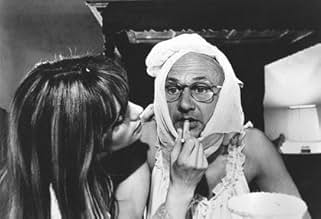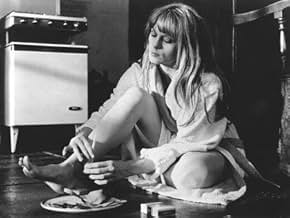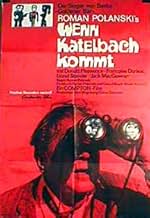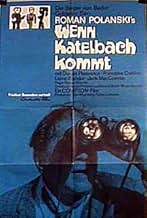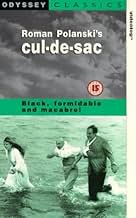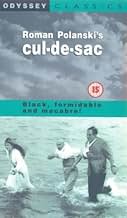Cul-de-sac
- 1966
- Tous publics
- 1h 52min
NOTE IMDb
7,0/10
15 k
MA NOTE
Deux gangsters blessés et en fuite trouvent refuge dans le château isolé d'un homme faible et de sa femme, en quête d'aide ; toutefois, sous la menace d'une arme à feu, les apparences sont t... Tout lireDeux gangsters blessés et en fuite trouvent refuge dans le château isolé d'un homme faible et de sa femme, en quête d'aide ; toutefois, sous la menace d'une arme à feu, les apparences sont trompeuses.Deux gangsters blessés et en fuite trouvent refuge dans le château isolé d'un homme faible et de sa femme, en quête d'aide ; toutefois, sous la menace d'une arme à feu, les apparences sont trompeuses.
- Réalisation
- Scénario
- Casting principal
- Nomination aux 1 BAFTA Award
- 1 victoire et 1 nomination au total
Jacqueline Bisset
- Jacqueline
- (as Jackie Bisset)
Avis à la une
Captivatingly bizarre movie. Dickie and Albie, both injured and on-the-run following a failed heist, stumble upon effeminate George and promiscuous Teresa's secluded castle on the shore. Lionel Stander as the menacingly uncouth thug Dickie is the standout in the cast as he takes over the household while waiting for the gang boss to come and get him and his partner. Donald Pleasence and Franciose Dorleac as the invaded couple were also excellent as they deal with not only the crooks but an unwelcome family visit. Not for everybody but if you're in the mood for something unusual from the 60s or just wanting to view an example of early Polaski .
This film is incredible. Polanski's best film behind Knife in the Water and Rosemary's Baby.
The plot revolves around a gangster (Lionel Stander) and his partner that seek refuge in a castle on a small island in England. The couple that inhabit the castle are played by the sublime Donald Pleasance and the beautiful Françoise Dorléac. The movie plays out like a three way triangle of hatred; we have the contempt between the couple and the gangster, who is invading their home; the gangster's mean streak is inflicted on the couple and the lady obviously holds her husband in low regard when he takes on the role of a wimp in front of the gun toting criminal. However, it is not as simple as that as in several points in the movie, the characters let their guard down and start to communicate with each other in an almost friendly way. This is the real beauty of this film; it is a character study, studying the relationship between a couple and a third party in their home. Three is a crowd, and the effects of that true to life phrase are felt by each of the three characters.
The three main players in Cul-De-Sac are fantastic, Lional Stander in particular who was surely born to play his role in this movie. He has the voice and the persona of a not very bright gangster spot on; his comic timing for some of his more obviously funny lines is also noteworthy. Donald Pleasance has never been better than he was here either; his portrayal as the 'lord of the manor' is both believable and intriguing. Last but not least, Françoise Dorléac, in undoubtedly the most overlooked role in the piece, although no less important than the other two, is also on time and believable in her role; making up a perfect cast.
From a relatively simple plot line and few characters, through excellent dialogue, restrained plotting and interesting scenarios, Roman Polanksi has managed to weave a story that is interesting and entertaining. Roman Polanski has a great flair for human relationships in his movies, the best example of this was in his best movie, Knife in the Water, and that element is abundant here too. The scenes in which all three characters are on screen interacting with each other are this movie's finest moments.
Cul-De-Sac is an excellent black comedy thriller that fans of the genre and fans of the excellent Roman Polanski will not want to miss. Recommended viewing
The plot revolves around a gangster (Lionel Stander) and his partner that seek refuge in a castle on a small island in England. The couple that inhabit the castle are played by the sublime Donald Pleasance and the beautiful Françoise Dorléac. The movie plays out like a three way triangle of hatred; we have the contempt between the couple and the gangster, who is invading their home; the gangster's mean streak is inflicted on the couple and the lady obviously holds her husband in low regard when he takes on the role of a wimp in front of the gun toting criminal. However, it is not as simple as that as in several points in the movie, the characters let their guard down and start to communicate with each other in an almost friendly way. This is the real beauty of this film; it is a character study, studying the relationship between a couple and a third party in their home. Three is a crowd, and the effects of that true to life phrase are felt by each of the three characters.
The three main players in Cul-De-Sac are fantastic, Lional Stander in particular who was surely born to play his role in this movie. He has the voice and the persona of a not very bright gangster spot on; his comic timing for some of his more obviously funny lines is also noteworthy. Donald Pleasance has never been better than he was here either; his portrayal as the 'lord of the manor' is both believable and intriguing. Last but not least, Françoise Dorléac, in undoubtedly the most overlooked role in the piece, although no less important than the other two, is also on time and believable in her role; making up a perfect cast.
From a relatively simple plot line and few characters, through excellent dialogue, restrained plotting and interesting scenarios, Roman Polanksi has managed to weave a story that is interesting and entertaining. Roman Polanski has a great flair for human relationships in his movies, the best example of this was in his best movie, Knife in the Water, and that element is abundant here too. The scenes in which all three characters are on screen interacting with each other are this movie's finest moments.
Cul-De-Sac is an excellent black comedy thriller that fans of the genre and fans of the excellent Roman Polanski will not want to miss. Recommended viewing
After their car becomes stuck on a causeway, two gangsters named Dickey and Albie find themselves stranded on the remote island of Lindisfarne. There, they take refuge in a castle owned by an eccentric couple, the mentally unbalanced George and his promiscuous and beautiful wife Teresa. The hoods proceed to hold George and Teresa hostage, until their boss Katelbach can send them some transportation off the rock. However, matters become complicated by the arrival of a group of George's friends, one of whom Teresa has an affair with. So begins 'Cul-de-sac,' a tale of madness, sexual frustration and pitch-black comedy that could only have come from the mind of Roman Polanski.
Original, abstract and frequently funny, Polanski's 'Cul-de-sac' is a fascinating, captivating movie that will delight any fan of the dark and strange. Much like his earlier 'Repulsion,' the film launches the viewer into a weird world populated by odd folk struggling with their desires and how to interact with the people around them. The characters engage in a power struggle throughout the film, with manipulation and thuggery being the prime weapons at their disposal. While the hoodlums take George and Teresa hostage, it is also Teresa who makes George a hostage of her lust, and it is she who does the most damage to his psyche.
It is a film that will likely spark differing opinions as to what the meaning of it all is. Some cinema-goers enjoy the guesswork, though others find abstractions infuriating; and 'Cul-de-sac' is not for the impatient or the shunners of philosophy. It's an intriguing, dark thriller that also happens to be one of Polanski's funniest outings, as he injects the narrative with much off-beat humor and sharp, banterous dialogue. The film still features his trademark examinations of paranoia, isolation and social unease; though told in a slightly lighter fashion than one accustomed to Polanski would expect (which, for this viewer anyway, comes as a boon to the proceedings).
'Cul-de-sac' is a visually enthralling flick, featuring arresting cinematography from Gilbert Taylor, who lent his talents to the previous 'Repulsion,' and would go on to work with Polanski once more on 'MacBeth.' Their collaborations made for undeniably artistic and powerful visuals that intrigue and impress, both in creative and technical terms. 'Cul-de-sac' boasts some incredible cinematography, from intense tracking shots to the masterful manipulation of light and shadows; Taylor's distinct and evocative work under Polanski's firm direction is unforgettable.
Alastair McIntyre was a frequent collaborator of Polanski's, and his editing for 'Cul-de-sac' is swift and smart. Reportedly, the two men toiled very closely together in the editing suite, developing over the years an intuitive and fruitful working relationship build on mutual respect and admiration. Looking at the remarkably tight, streamlined final cut of 'Cul-de-sac;' it's easy to see why Polanski utilized McIntyre on six films- his work is nigh on flawless.
Also of note is the score from Krzysztof Komeda, which is jazzy and strangely haunting; like elevator music from Dante's second circle of hell. His melodies fit perfectly the images of the film, as odd and as unsettling as some of them may be. Additionally, Bridget Sellers' rich costume design and George Lack's detailed set decoration and art direction lends the film additional impact and depth to the locales and characters.
'Cul-de-sac' stars Donald Pleasence as George, Françoise Dorléac as Teresa and Lionel Stander as Dickey, with the three of them turning in strong performances that are highlights in each of their filmographies. Pleasence is terrific as the unhinged, deeply neurotic George, imbuing him with an almost childlike quality which makes the character all the more interesting and odd. Though sometimes in films Pleasence had a tendency to go a little over-the-top, here he remains grounded, despite the weirdness of the role; doing consummate work that is hard to forget.
Dorléac- who tragically died before making it as big internationally as her sister Catherine Deneuve- is nothing short of a sensation as Teresa, giving a performance of wit, intelligence and depth that is a real treat to watch. As wily and as seductive as a panther in the night, Dorléac is not afraid to make Teresa unlikable, though she remains charismatic throughout. From her all too short career in film, Dorléac's assured performance in 'Cul-de-sac' is her greatest and most compelling.
Finally, Lionel Stander is brilliant as Dickey, the humorous hoodlum who takes hostage and tries to manipulate George and Teresa. Stander was a talented actor whose screen presence- like Ernest Borgnine- was such that you'd warm to him no matter what he did, evil or nay. With his crooked grin and gravelly voice, he leaves an indelible impression on the viewer; making Dickey a character that is most memorable. The supporting cast all perform admirably too, with a young Jacqueline Bisset and Jack MacGowran impressing the most.
Roman Polanski's 'Cul-de-sac' is a powerful and off-beat thriller that has a lot to offer viewers. Featuring an atmospheric Krzysztof Komeda score, stunning visuals from Gilbert Taylor and a cast performing at the top of their games; there is very little not to praise about the movie. If you enjoy films of abstractions and you have not seen it before, it is advisable that you do so now; as 'Cul-de-sac' is a weird, wild and wonderful movie that is not to be missed.
Original, abstract and frequently funny, Polanski's 'Cul-de-sac' is a fascinating, captivating movie that will delight any fan of the dark and strange. Much like his earlier 'Repulsion,' the film launches the viewer into a weird world populated by odd folk struggling with their desires and how to interact with the people around them. The characters engage in a power struggle throughout the film, with manipulation and thuggery being the prime weapons at their disposal. While the hoodlums take George and Teresa hostage, it is also Teresa who makes George a hostage of her lust, and it is she who does the most damage to his psyche.
It is a film that will likely spark differing opinions as to what the meaning of it all is. Some cinema-goers enjoy the guesswork, though others find abstractions infuriating; and 'Cul-de-sac' is not for the impatient or the shunners of philosophy. It's an intriguing, dark thriller that also happens to be one of Polanski's funniest outings, as he injects the narrative with much off-beat humor and sharp, banterous dialogue. The film still features his trademark examinations of paranoia, isolation and social unease; though told in a slightly lighter fashion than one accustomed to Polanski would expect (which, for this viewer anyway, comes as a boon to the proceedings).
'Cul-de-sac' is a visually enthralling flick, featuring arresting cinematography from Gilbert Taylor, who lent his talents to the previous 'Repulsion,' and would go on to work with Polanski once more on 'MacBeth.' Their collaborations made for undeniably artistic and powerful visuals that intrigue and impress, both in creative and technical terms. 'Cul-de-sac' boasts some incredible cinematography, from intense tracking shots to the masterful manipulation of light and shadows; Taylor's distinct and evocative work under Polanski's firm direction is unforgettable.
Alastair McIntyre was a frequent collaborator of Polanski's, and his editing for 'Cul-de-sac' is swift and smart. Reportedly, the two men toiled very closely together in the editing suite, developing over the years an intuitive and fruitful working relationship build on mutual respect and admiration. Looking at the remarkably tight, streamlined final cut of 'Cul-de-sac;' it's easy to see why Polanski utilized McIntyre on six films- his work is nigh on flawless.
Also of note is the score from Krzysztof Komeda, which is jazzy and strangely haunting; like elevator music from Dante's second circle of hell. His melodies fit perfectly the images of the film, as odd and as unsettling as some of them may be. Additionally, Bridget Sellers' rich costume design and George Lack's detailed set decoration and art direction lends the film additional impact and depth to the locales and characters.
'Cul-de-sac' stars Donald Pleasence as George, Françoise Dorléac as Teresa and Lionel Stander as Dickey, with the three of them turning in strong performances that are highlights in each of their filmographies. Pleasence is terrific as the unhinged, deeply neurotic George, imbuing him with an almost childlike quality which makes the character all the more interesting and odd. Though sometimes in films Pleasence had a tendency to go a little over-the-top, here he remains grounded, despite the weirdness of the role; doing consummate work that is hard to forget.
Dorléac- who tragically died before making it as big internationally as her sister Catherine Deneuve- is nothing short of a sensation as Teresa, giving a performance of wit, intelligence and depth that is a real treat to watch. As wily and as seductive as a panther in the night, Dorléac is not afraid to make Teresa unlikable, though she remains charismatic throughout. From her all too short career in film, Dorléac's assured performance in 'Cul-de-sac' is her greatest and most compelling.
Finally, Lionel Stander is brilliant as Dickey, the humorous hoodlum who takes hostage and tries to manipulate George and Teresa. Stander was a talented actor whose screen presence- like Ernest Borgnine- was such that you'd warm to him no matter what he did, evil or nay. With his crooked grin and gravelly voice, he leaves an indelible impression on the viewer; making Dickey a character that is most memorable. The supporting cast all perform admirably too, with a young Jacqueline Bisset and Jack MacGowran impressing the most.
Roman Polanski's 'Cul-de-sac' is a powerful and off-beat thriller that has a lot to offer viewers. Featuring an atmospheric Krzysztof Komeda score, stunning visuals from Gilbert Taylor and a cast performing at the top of their games; there is very little not to praise about the movie. If you enjoy films of abstractions and you have not seen it before, it is advisable that you do so now; as 'Cul-de-sac' is a weird, wild and wonderful movie that is not to be missed.
A wounded criminal and his dying partner take up refuge at a beachfront villa, which (not surprisingly) makes the owners less than thrilled.
I watched this as part of my quest to see all of Polanski's films in order. After two psychological films, he has switched to comedy... and I am not entirely sure I get it. Visually, this film is quite stunning and it has some good camera work (including one of the longest continuous sequences in cinematic history at the time of release at 7 minutes and 28 seconds).
Jack Nicholson claimed in an interview in 2007 that this is his favorite film. Not sure what to make of that. I loved Donald Pleasance as the cross-dressing wimp, but beyond that, I just do not think I really got it... the humor was not so strong and the darkness was not all that dark.
I watched this as part of my quest to see all of Polanski's films in order. After two psychological films, he has switched to comedy... and I am not entirely sure I get it. Visually, this film is quite stunning and it has some good camera work (including one of the longest continuous sequences in cinematic history at the time of release at 7 minutes and 28 seconds).
Jack Nicholson claimed in an interview in 2007 that this is his favorite film. Not sure what to make of that. I loved Donald Pleasance as the cross-dressing wimp, but beyond that, I just do not think I really got it... the humor was not so strong and the darkness was not all that dark.
As 'Cul-de-sac' was Polanski's first movie after his brilliant psychological thriller 'Repulsion' it can't help but be a slight disappointment. Even so, I thought it was an interesting movie and I found it to be much more enjoyable than his next one the totally unfunny spoof 'The Fearless Vampire Killers'. 'Cul-de-sac' is quite difficult to catergorise. In some ways it reminded me of Pinter's 'The Birthday Party' (filmed much later than this but originally staged in the late 1950s), in others of Jack Hill's cult favourite 'Spider Baby' (made earlier but not really released until afterwards), and you could almost see it as prefiguring 'Performance' (old school gangsters meet the new world of the swinging 1960s). But really it quite an odd and unique black comedy. It may not be 100% successful, and it does have a few dull spots, but overall it's worth tracking down if you want to see something different. The main reason it succeeds for me is the unusual location of Lindisfarne, England (which I have visited), and the performances of Donald Pleasence, Francoise Dorleac and Lionel Stander. Pleasence was one of Britain's most underrated character actors, the beautiful and doomed Dorleac had appeared alongside Jean-Paul Belmondo in the entertaining thriller 'That Man From Rio', and Standish, who later appeared in movies by Leone and Spielberg, is best remembered as Max, the craggy manservant on the popular 1980s TV show 'Hart To Hart'. All three are excellent in this movie, and their interaction make it fascinating viewing. The supporting cast also includes Jack MacGowran ('The Exorcist') and an early appearance by 1970s sex symbol Jacqueline Bisset. 'Cul-de-sac' is without a doubt Polanski's most underrated movie, and fans of the unusual and the off beat will enjoy it very much. A DVD with a commentary from Polanski would would be wonderful. Any chance?
Le saviez-vous
- AnecdotesRoman Polanski shot 16 takes of the scene in which Lionel Stander drinks a pint of milk.
- GaffesWhen Dickie is pushing the car, the shadow of the camera and the cameraman can be seen on him.
- Versions alternativesThe VHS version released in Brazil by Globo Vídeo has exactly 100 minutes.
- ConnexionsFeatured in Le ciné-club de Radio-Canada: Film présenté: Cul-de-sac (1975)
Meilleurs choix
Connectez-vous pour évaluer et suivre la liste de favoris afin de recevoir des recommandations personnalisées
Détails
- Date de sortie
- Pays d’origine
- Site officiel
- Langue
- Aussi connu sous le nom de
- Ćorsokak
- Lieux de tournage
- Sociétés de production
- Voir plus de crédits d'entreprise sur IMDbPro
Box-office
- Montant brut mondial
- 1 500 $US
- Durée1 heure 52 minutes
- Couleur
- Rapport de forme
- 1.66 : 1
Contribuer à cette page
Suggérer une modification ou ajouter du contenu manquant

Lacune principale
By what name was Cul-de-sac (1966) officially released in India in English?
Répondre

